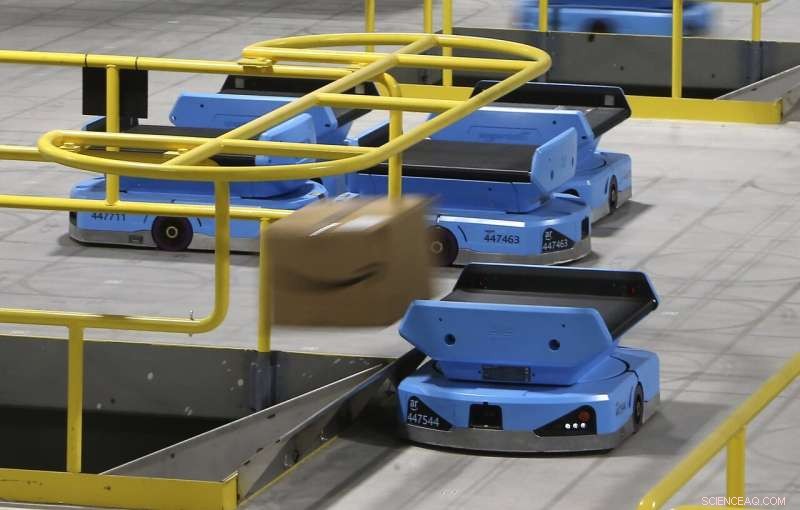
In questo 17 dicembre, 2019, foto un robot Amazon manda un pacco giù per uno scivolo, trasporto di pacchi dai lavoratori agli scivoli organizzati per codice postale, presso un magazzino Amazon a Goodyear, Ariz. Il gigante della tecnologia sta ancora lanciando nuovi modelli discesi dalla linea Kiva, compreso il Pegaso, un veicolo squadrato con un nastro trasportatore in cima che può essere trovato mentre lavora al primo turno del mattino in un magazzino nel sobborgo di Goodyear a Phoenix. (Foto AP/Ross D. Franklin)
Indovina chi si sta abituando a lavorare con i robot nella vita di tutti i giorni? Gli stessi magazzinieri una volta prevedevano di perdere il lavoro a causa di sostituzioni meccaniche.
Ma svolgere il proprio lavoro fianco a fianco con i robot non è facile. Secondo i loro creatori, le macchine dovrebbero svolgere i compiti più banali e fisicamente faticosi. In realtà, stanno anche creando nuove forme di stress e tensione sotto forma di lesioni e il disagio di lavorare in spazi ristretti con dispositivi mobili da mezza tonnellata che si dirigono da soli.
"Pesano molto, " Ha detto la lavoratrice di Amazon Amanda Taillon durante la corsa pre-natalizia in un magazzino aziendale nel Connecticut. Nelle vicinanze, una flotta di scaffali per robot itineranti alti un metro e ottanta si aggirava dietro una recinzione di rete metallica.
Il compito di Taillon è quello di entrare in una gabbia e domare i robot del magazzino su ruote di Amazon abbastanza a lungo da raccogliere un giocattolo caduto o alleviare un ingorgo. Si allaccia una cintura multiuso illuminata che funziona come il campo di forza di un supereroe, comandando ai robot più vicini di fermarsi bruscamente e agli altri di rallentare o regolare i loro percorsi.
"Quando sei là fuori, e puoi sentirli muoversi, ma non puoi vederli, è come, 'Da dove verranno?', ", ha detto. "All'inizio è un po' snervante".
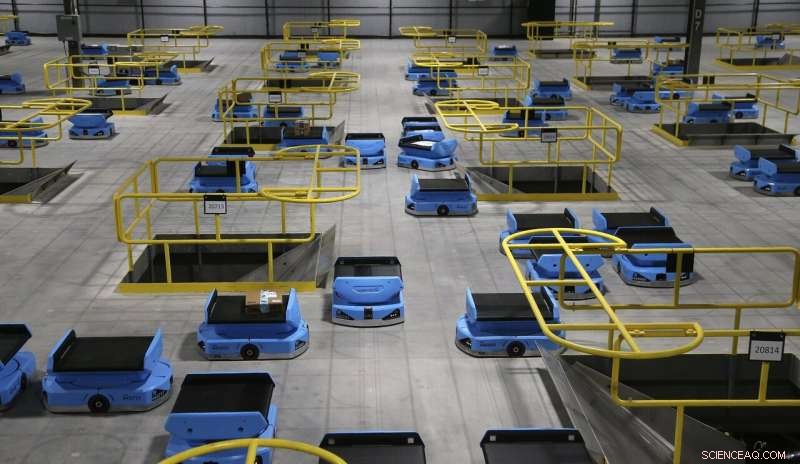
In questo 17 dicembre, 2019, foto dozzine di robot Amazon trasportano pacchi dai lavoratori agli scivoli organizzati per codice postale, presso un magazzino Amazon a Goodyear, Ariz. Amazon e i suoi rivali richiedono sempre più ai dipendenti del magazzino di abituarsi a lavorare con i robot. L'azienda ha ora più di 200, 000 veicoli robotici che chiama "unità" che spostano le merci attraverso i suoi centri di consegna negli Stati Uniti (AP Photo/Ross D. Franklin)
Taillon afferma di essersi abituata a lavorare con i robot, qualcosa che Amazon e i suoi rivali richiedono sempre più spesso ai dipendenti del magazzino. Amazon ora ne ha più di 200, 000 veicoli robotici che chiama "azionamenti" che spostano le merci attraverso i suoi centri di consegna negli Stati Uniti. È il doppio del numero che aveva l'anno scorso e da 15, 000 unità nel 2014.
I suoi rivali se ne sono accorti, e molti stanno aggiungendo i propri robot in una corsa per accelerare la produttività e ridurre i costi.
Senza questi baccelli in rapido movimento, bracci robotici e altre forme di automazione del magazzino, i rivenditori affermano che non sarebbero in grado di soddisfare la domanda dei consumatori per i pacchetti che possono arrivare a casa il giorno dopo averli ordinati online.
Ma mentre i timori che i robot sostituiranno i lavoratori umani non si sono concretizzati, ci sono crescenti preoccupazioni che stare al passo con la più recente tecnologia di intelligenza artificiale stia mettendo a dura prova la salute dei lavoratori umani, sicurezza e morale.
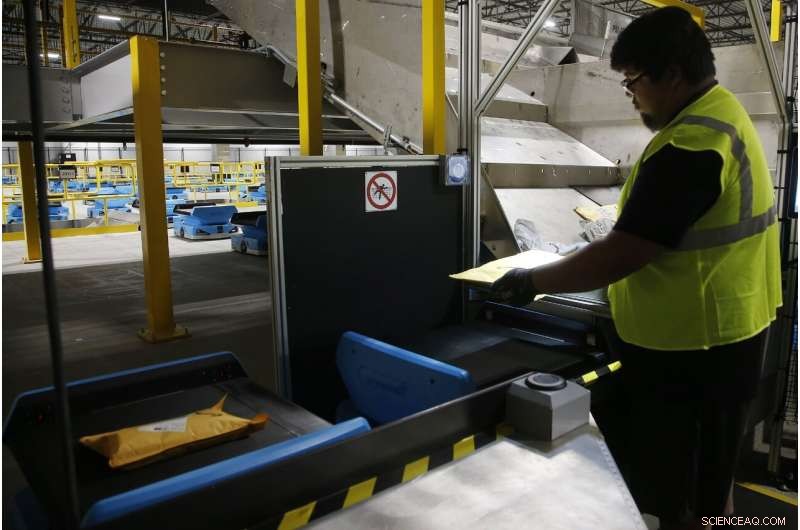
In questo 17 dicembre, 2019, foto Joseph Salinas posiziona i pacchi sui robot Amazon, trasporto di pacchi dai lavoratori agli scivoli organizzati per codice postale, presso un magazzino Amazon a Goodyear, Ariz. I magazzini alimentati da robotica e software di intelligenza artificiale stanno portando al burnout umano aggiungendo più lavoro e aumentando la pressione sui lavoratori per accelerare le loro prestazioni, disse Beth Gutelius, che studia sviluppo economico urbano presso l'Università dell'Illinois a Chicago e ha intervistato operatori di magazzino negli Stati Uniti (AP Photo/Ross D. Franklin)
I magazzini alimentati da robotica e software di intelligenza artificiale stanno portando al burnout umano aggiungendo più lavoro e aumentando la pressione sui lavoratori per accelerare le loro prestazioni, disse Beth Gutelius, che studia sviluppo economico urbano presso l'Università dell'Illinois a Chicago e ha intervistato operatori di magazzino negli Stati Uniti.
Non è che i lavoratori non vengano addestrati su come lavorare con i robot in sicurezza. "Il problema è che diventa molto difficile farlo quando gli standard di produttività sono così alti, " lei disse.
Gran parte del boom della robotica di magazzino ha le sue radici nell'acquisto da parte di Amazon da 775 milioni di dollari della startup del Massachusetts Kiva Systems nel 2012. Il gigante della tecnologia l'ha rinominata Amazon Robotics e l'ha trasformata in un laboratorio interno che da sette anni progetta e costruire l'armata di robot di Amazon.
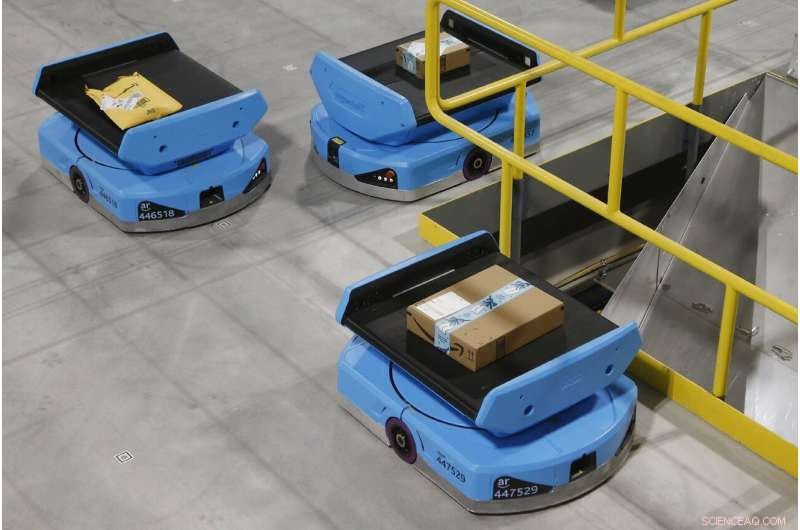
In questo 17 dicembre, 2019, foto I robot di Amazon si muovono lungo il pavimento del magazzino con i pacchi prima di trovare lo scivolo di consegna adeguato, trasporto di pacchi dai lavoratori agli scivoli organizzati per codice postale, presso un magazzino di Amazon a Goodyear, Ariz. Amazon e i suoi rivali richiedono sempre più ai dipendenti del magazzino di abituarsi a lavorare con i robot. L'azienda ha ora più di 200, 000 veicoli robotici che chiama "unità" che spostano merci attraverso i suoi centri di consegna negli Stati Uniti (AP Photo/Ross D. Franklin)
L'acquisto di Kiva da parte di Amazon "ha dato il tono a tutti gli altri rivenditori affinché si alzino e prestino attenzione, " ha detto Jim Liefer, CEO della startup di San Francisco Kindred AI, che crea un braccio robotico artificialmente intelligente che afferra e ordina articoli per rivenditori come The Gap.
A rush of venture capital and private sector investment in warehouse robotics spiked to $1.5 billion a year in 2015 and has remained high ever since, said Rian Whitton, a robotics analyst at ABI Research.
Canadian e-commerce company Shopify spent $450 million this fall to buy Massachusetts-based startup 6 River Systems, which makes an autonomous cart nicknamed Chuck that can follow workers around a warehouse. Other mobile robot startups are partnering with delivery giants such as FedEx and DHL or retailers such as Walmart.
Amazon this year bought another warehouse robotics startup, Colorado-based Canvas Technology, which builds wheeled robots guided by computer vision. Such robots would be more fully autonomous than Amazon's current fleet of caged-off vehicles, which have to follow bar codes and previously mapped routes within warehouses.
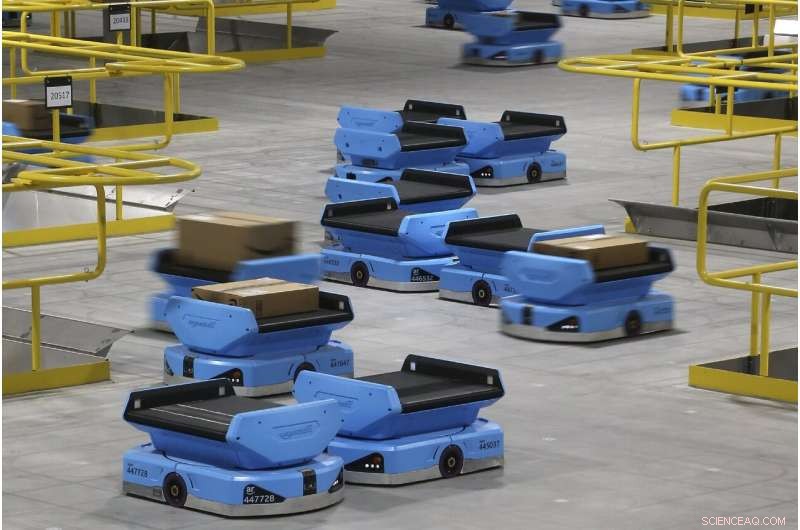
In this Dec. 17, 2019, photo Amazon robots zip along the a warehouse floor, transporting packages from workers to chutes that are organized by zip code, at an Amazon warehouse facility in Goodyear, Ariz. Amazon and its rivals are increasingly requiring warehouse employees to get used to working with robots. The company now has more than 200, 000 robotic vehicles it calls "drives" that are moving goods through its delivery-fulfillment centers around the U.S. (AP Photo/Ross D. Franklin)
The tech giant is also still rolling out new models descended from the Kiva line, including the Pegasus, a squarish vehicle with a conveyor belt on top that can be found working the early-morning shift at a warehouse in the Phoenix suburb of Goodyear, Arizona. A crisscrossing fleet of robots carries packaged items across the floor and drops them into chutes based on the zip code of their final destination.
All of this is transforming warehouse work in a way that the head of Amazon Robotics says can "extend human capability" by shifting people to what they are best at:problem-solving, common sense and thinking on their feet.
"The efficiencies we gain from our associates and robotics working together harmoniously—what I like to call a symphony of humans and machines working together—allows us to pass along a lower cost to our customer, " said Tye Brady, Amazon Robotics' chief technologist.
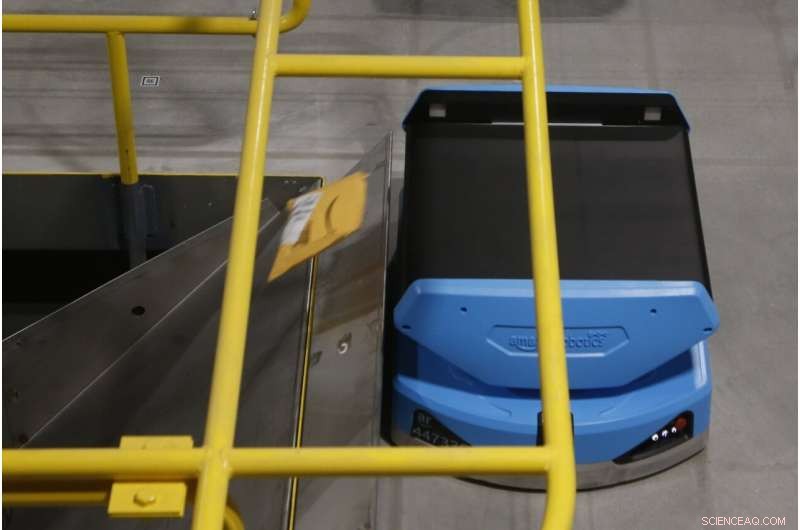
In this Dec. 17, 2019, photo an Amazon robot sends a package down a chute, transporting packages from workers to chutes that are organized by zip code, at an Amazon warehouse facility in Goodyear, Ariz. Warehouses powered by robotics and AI software are leading to human burnout by adding more work and upping the pressure on workers to speed up their performance, said Beth Gutelius, who studies urban economic development at the University of Illinois at Chicago and has interviewed warehouse operators around the U.S. (AP Photo/Ross D. Franklin)
Brady said worker safety remains the top priority and ergonomic design is engineered into the systems at the beginning of the design stage. Gutelius, the University of Illinois researcher, said that the aspiration for symphonic human-machine operations is not always working out in practice.
"It sounds quite lovely, but I rarely hear from a worker's perspective that that's what it feels like, " lei disse.
Gutelius co-authored a report published this fall that found new warehouse technology could contribute to wage stagnation, higher turnover and poorer quality work experiences because of the way AI software can monitor and micro-manage workers' behaviors.
A recent journalistic investigation of injury rates at Amazon warehouses from The Center for Investigative Reporting's Reveal found that robotic warehouses reported more injuries than those without.
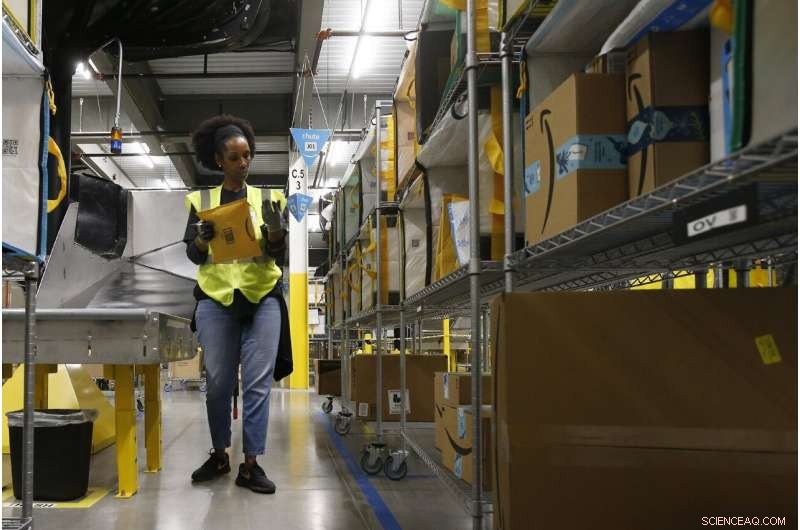
In this Dec. 17, 2019, photo Tahsha Sydnor stows packages into special containers after Amazon robots deliver separated packages by zip code at an Amazon warehouse facility in Goodyear, Ariz. Amazon and its rivals are increasingly requiring warehouse employees to get used to working with robots. The company now has more than 200, 000 robotic vehicles it calls "drives" that are moving goods through its delivery-fulfillment centers around the U.S. (AP Photo/Ross D. Franklin)
Reveal looked at records from 28 Amazon warehouses in 16 states and found that the overall rate of serious injuries was more than double the warehousing industry average. Amazon has countered it's misleading to compare its rate with rivals because of the company's "aggressive stance on recording injuries no matter how big or small."
The Reveal report also found a correlation between robots and safety problems, such as in Tracy, California, where the serious injury rate nearly quadrupled in the four years after robots were introduced.
Melonee Wise, CEO of California-based Fetch Robotics, which sells its autonomous robotic carts to retailers and other clients, credits Amazon's Kiva acquisition for propelling innovation in the industry.
But she said that Amazon's system forces workers to do "un-ergonomic moves" such as reaching up high or crouching down to pick out and stow inventory into the shelves-on-wheels.
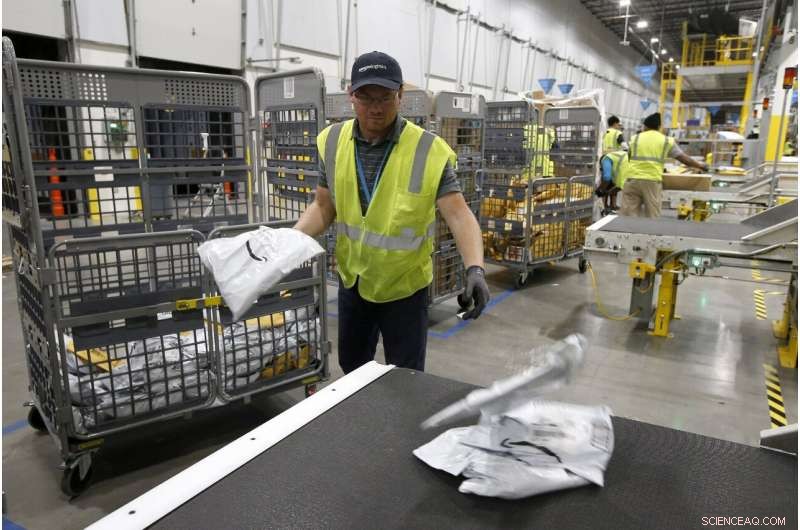
In this Dec. 17, 2019, photo Steven Smith places packages onto a conveyor prior to Amazon robots transporting packages to chutes that are organized by zip code, at an Amazon warehouse facility in Goodyear, Ariz. (AP Photo/Ross D. Franklin)
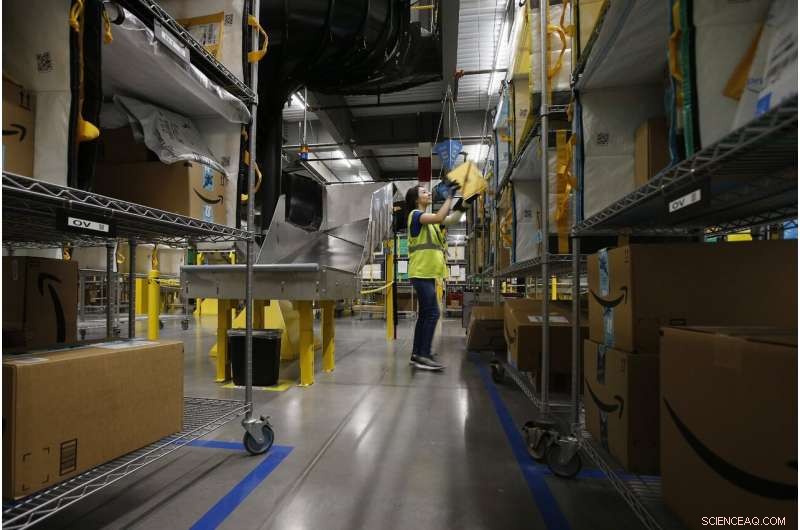
In this Dec. 17, 2019, photo Jocelyn Nieto stows packages into special containers after Amazon robots deliver separated packages by zip code at an Amazon warehouse facility in Goodyear, Ariz. Doing your job side-by-side with robots isn't easy. According to their makers, the machines should take on the most mundane and physically strenuous tasks. In realtà, they're also creating new forms of stress and strain in the form of injuries and just the unease of working in close quarters with mobile half-ton devices that direct themselves. (Foto AP/Ross D. Franklin)
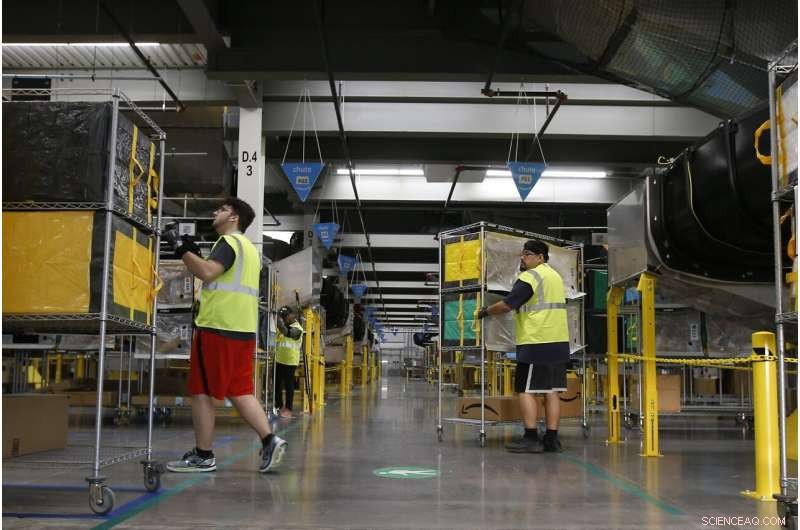
In this Dec. 17, 2019, photo Amazon workers bring stowed containers to their specific trucks after Amazon robots deliver separated packages by zip code at an Amazon warehouse facility in Goodyear, Ariz. (AP Photo/Ross D. Franklin)
"They have robots that live in cages, " she said. "Our robots are designed to work safely around people, which is a very large distinction between the two systems."
Amazon hasn't disclosed how its safety record at robot-powered warehouses compares to those without. But company officials remain optimistic that Amazon workers are adapting to the new technology.
At a visit with a reporter earlier in December to the warehouse in North Haven, Connecticut, Brady was explaining the workings of a powerful robotic arm called a "palletizer" when crates it was stacking on a pallet started tumbling over. Unfazed by the temporary malfunction, he watched as an employee disabled the machine, discovered an apparent structural weakness in the pallet, adjusted the stack of crates and let the robot get back to work.
"His ability to problem-solve that was like this, " Brady said, enthusiastically snapping his fingers. "What I love about that is it's humans and machines working together."
© 2019 The Associated Press. Tutti i diritti riservati.